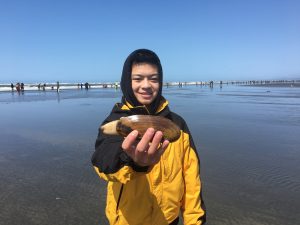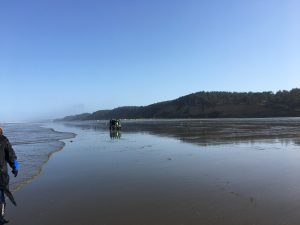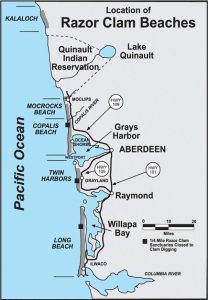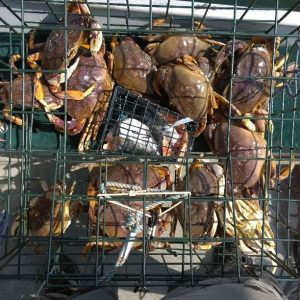Coastal razor clam digs on near horizon and winter Puget Sound crab announcement expected at end of next month Leave a reply
Tentative coastal razor clam digging dates have been set and Long Beach will see one of the shortest seasons in more than two decades although albeit shellfish managers are hopeful it is just a one-year anomaly.
“Long Beach is faced with a gap year (for digging in 2018-19), and there are clams on the beach but they’re just really small,” said Dan Ayres, the head coastal WDFW shellfish manager.
“We lost a lot of clams in the winter before last, and coincidentally we were faced with low salinity levels (from Columbia River run-off),” Ayres said. “I heard from ODFW and they’re faced with the same situation and are considering some action on their side of the Columbia.”
Long Beach has about 330,000 clams available for harvest in 2018-19, but Ayres points out that 80 percent of them are less than 2-inches long.
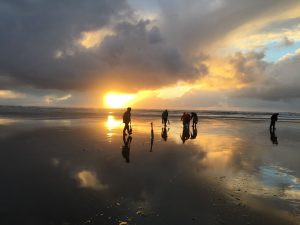
Sunsets can be dramatic during fall and winter evening low tides, and razor clam digging off coast should be decent. Photo by Mark Yuasa.
“We will have one dig (on Dec. 22 only) at Long Beach, and if our data is solid then we might be able to give them more digs in the late winter and spring,” Ayres said. “It gives us a chance to look closely at what is there and what to do next. We have promised (the Long Beach) community that we will allow for some digs to occur during their razor clam festival (on April 20).”
Other coastal beaches look much more robust for the upcoming fall and winter digs.
“It won’t be off the charts good and much more like a normal digging year, and beaches north of Grays Harbor will see much better than normal digging,” Ayres said. “Our summer assessment at Twin Harbors was much better than what I thought it would be and we are good with that news.”
Copalis and Mocrocks beaches razor clam populations are up over last year, and WDFW plans to schedule a good number of digging opportunity on those beaches.
“On other beaches clams aren’t monsters but they are in good shape and definitely not as small as Long Beach,” Ayres said. “For the most part we should see a great season for digging on the coast.”
WDFW is working with Olympic National Park staff to assess possible digging dates on Kalaloch Beach.
“Kalaloch is looking good and better than it has been in a long time,” Ayres said. “Razor clam growth at Kalaloch is puzzling and for some reason they don’t seem to grow as fast there.”
In all the 2018-19 total allowable catch share of razor clams is 333,557 with a projected daily harvest of 60,000 at Long Beach; 1,377,125 with 35,000 at Twin Harbors; 860,768 with 50,000 at Copalis; 1,508,774 with 40,000 at Mocrocks; and 777,386 at Kalaloch.
Digging in the 2017-18 season generated a harvest of 2.7-million razor clams for 257,000 digger trips and 11.0 clams per digger trip (the daily limit is the first 15 clams dug regardless of size or condition).
A breakdown of last season showed diggers at Long Beach averaged 8.9 clams per trip for 16 days of digging (11 days in 2016-17 and 94 in 2015-16); Twin Harbors averaged 11.3 for 18 days (46 and none); Copalis averaged 13.1 for 12 days (33 and 18); and Mocrocks averaged 12.5 for 20 days (35 and 26).
Upcoming digs are reliant on testing for marine toxins known as domoic acid — a natural marine toxin produced by certain types of marine algae. Clams with high amounts of marine toxins can be harmful or even fatal if consumed in sufficient quantities.
Domoic acid levels remained well under the 20 parts-per-million cutoff ranging from 0.0 to 2.0.
Fall and winter razor clam digs occur during evening low tides while spring-time digs occur during morning low tides.
Here are the proposed digging dates, and final approval will usually be announced about one or two weeks before each series of digs:
Oct. 11 (minus-0.6 feet at 8:58 p.m.) at Twin Harbors and Mocrocks; Oct. 12 (-0.3 at 9:41 p.m.) at Twin Harbors and Copalis; Oct. 13 (0.1 at 10:26 p.m.) at Twin Harbors and Mocrocks; Oct. 25 (-0.5 at 7:55 p.m.) at Twin Harbors and Copalis; Oct. 26 (-0.7 at 8:36 p.m.) at Twin Harbors and Mocrocks; Oct. 27 (-0.7 at 9:19 p.m.) at Twin Harbors and Copalis; and Oct. 28 (-0.6 at 10:08 p.m.) at Twin Harbors and Mocrocks.
Nov. 8 (-0.8 at 6:57 p.m.) at Twin Harbors and Mocrocks; Nov. 9 (-0.7 at 7:36 p.m.) at Twin Harbors and Copalis; Nov. 10 (-0.4 at 8:15 p.m.) at Twin Harbors and Mocrocks; Nov. 11 (0.0 at 8:56 p.m.) at Twin Harbors and Copalis; Nov. 22 (-0.7 at 5:55 p.m.) at Twin Harbors and Copalis; Nov. 23 (-1.1 at 6:36 p.m.) at Twin Harbors and Mocrocks; Nov. 24 (-1.3 at 7:20 p.m.) at Twin Harbors, Copalis and Mocrocks; and Nov. 25 (-1.3 at 8:05 p.m.) at Twin Harbors and Mocrocks.
Dec. 6 (-0.7 at 6:01 p.m.) Twin Harbors and Copalis; Dec. 7 (-0.7 at 6:40 p.m.) at Twin Harbors and Mocrocks; Dec. 8 (-0.6 at 7:16 p.m.) at Twin Harbors and Copalis; Dec. 9 (-0.4 at 7:53 p.m.) at Twin Harbors and Mocrocks; Dec. 20 (-0.3 at 4:51 p.m.) at Twin Harbors and Mocrocks; Dec. 21 (-1.0 at 5:35 p.m.) at Twin Harbors and Copalis; Dec. 22 (-1.4 at 6:20 p.m.) at Long Beach, Twin Harbors and Mocrocks; and Dec. 23 (-1.6 at 7:05 p.m.) at Twin Harbors and Copalis.
For details, visit https://wdfw.wa.gov/fishing/shellfish/razorclam.
Winter Puget Sound Dungeness crab outlook
If you like to winter Dungeness crab as much as I do, then pay close attention to a forthcoming announcement from WDFW in the weeks ahead about a possible winter crab fishing season.
“Hopefully we’ll have a preliminary estimate soon so that we can make some decisions on a winter crab season,” said Don Velasquez, a WDFW Puget Sound shellfish manager.
Fishing areas with crab remaining on their annual allocation, will re-open, seven days a week through the end of the year. However, if the entire annual sport catch quota was taken or if it was closed this past summer, then it’s game over for this winter.
“Some said crabbing was fine and others were asking what’s wrong,” Velasquez said. “We had a mixed bag of reports from Area 7 (San Juan Islands) and 8-1 and 8-2 (east side of Whidbey Island) had an average year.”
Velasquez said sport anglers who got out during the July opener in Area 9 (northern Puget Sound) benefitted with good catches as the tribal fisheries didn’t get out until a couple weeks later. Preseason test fisheries conducted by WDFW in Area 10 (central Puget Sound) showed a low abundance of crab thus leading to poor success this past summer.
For more information, go to https://wdfw.wa.gov/fishing/shellfish/.


